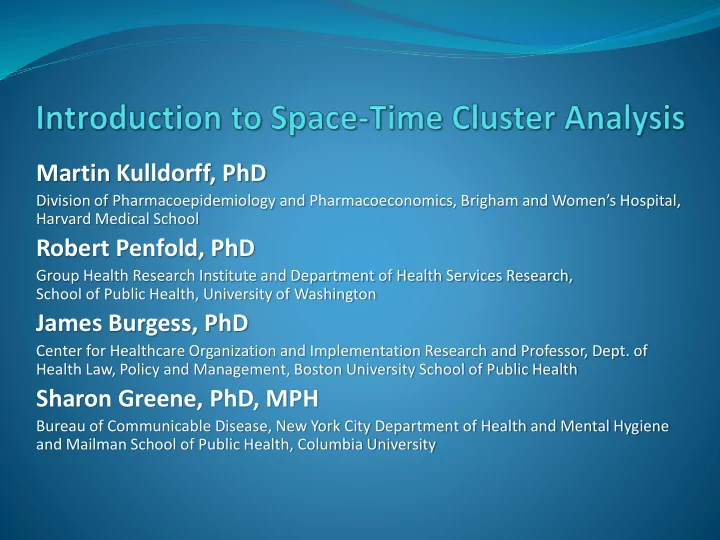

Martin Kulldorff, PhD Division of Pharmacoepidemiology and Pharmacoeconomics , Brigham and Women’s Hospital, Harvard Medical School Robert Penfold, PhD Group Health Research Institute and Department of Health Services Research, School of Public Health, University of Washington James Burgess, PhD Center for Healthcare Organization and Implementation Research and Professor, Dept. of Health Law, Policy and Management, Boston University School of Public Health Sharon Greene, PhD, MPH Bureau of Communicable Disease, New York City Department of Health and Mental Hygiene and Mailman School of Public Health, Columbia University
Introduction Brief overview of methods Why use space-time cluster analysis? Calculation of a scan statistic Three case studies Retrospective analysis of new psychotropic medication use among Medicaid youth in Michigan Retrospective analysis of the spread of new antipsychotic prescribing for Bipolar Disorder in the VA Prospective cluster detection of GI illness in Northern California and of reportable diseases in New York City. Discussion/Q&A about use of space-time cluster analysis
Why Use a Scan Statistic? With “outbreaks”: We do not know where they will occur. We do not know their geographical size. We do not know when they will occur. We do not know how rapidly they will emerge/spread.
Importance of Early Outbreak Detection Earlier identification of new cases Quarantine cases Warn about risk factors Eliminate health hazards and low value care Scientific research concerning policies and treatments
Space-Time Scan Statistic Use a cylindrical window, with the circular base representing space and the height representing time.
1. For each cylinder: • Obtain actual and expected number of cases inside and outside the cylinder. • Calculate likelihood function. 2. Compare Cylinders: • Pick cylinder with highest likelihood function as most likely cluster. 3. Inference: • Generate random replicas of the data set under the null-hypothesis of no clusters (Monte Carlo sampling). • Compare most likely clusters in real and random data sets (Likelihood ratio test).
A Space-Time Permutation Scan Statistic for Disease Outbreak Detection • Cases only • To be used when there is no reliable denominator data or; • When rate-based inference is not appropriate Kulldorff M, Heffernan R, Hartman J, Assunção R, Mostashari F. A space-time permutation scan statistic for disease outbreak detection. PLoS Medicine, 2005, 2:216-224.
Space-Time Permutation Scan Statistic 1. For each cylinder, calculate the expected number of cases conditioning on the marginals where c zd = # cases in location z at time d and C = total number of cases
Space-Time Permutation Scan Statistic Expected number of cases in cylinder A is the sum of all space-time days within that cylinder The probability of a particular observed count 2. occurring is given by the hypergeometric distribution
Space-Time Permutation Scan Statistic When the sum of cases for each spatial and temporal 3. unit is small compared to the total number of cases, the Poisson distribution can be used to approximate (4) and we can use the Poisson Generalized Likelihood Ratio to measure evidence of an outbreak:
Space-Time Permutation Scan Statistic Of all cylinders evaluated, the one with the greatest GLR is the least likely to occur by chance.
Space-Time Permutation Scan Statistic 4. Generate random replicas of the data set conditioned on the marginals, by permuting the pairs of spatial locations and times. 5. Compare test statistic in real and random (simulated) data sets using Monte Carlo hypothesis testing (Dwass, 1957): p-value = R(GLR max ) / (1+ # simulations)
Space-Time Permutation Scan Statistic: Properties • Adjusts for purely geographical clusters. • Adjusts for purely temporal clusters. • Simultaneously tests for outbreaks of any size at any location, by using a cylindrical windows with variable radius and height. • Accounts for multiple testing. • Aggregated or non-aggregated data (counties, zip- code areas, census tracts, individuals, etc).
Other Probability Models Counts: Bernoulli: cases vs. controls Discrete Poisson Space-time permutation Multinomial, Ordinal Exponential: survival time Normal: continuous distribution Satscan Users Guide http://www.satscan.org/cgi-bin/satscan/register.pl/SaTScan_Users_Guide.pdf?todo=process_userguide_download
Health Care Policy Questions Were individuals in some places more likely to have ___ occur after implementation of policy _____? Are individuals in some places doing ____ at a faster rate than other places? If we conduct real-time surveillance, could we target resources to stop ____ from happening?
What do I need? A good hypothesis and plausible contagion mechanism Event data: new infections, new diagnoses, new prescriptions, new injuries, . . . Time and location for every event Unit of time or space does not matter Download SatScan (free) http://www.satscan.org/
Recommend
More recommend